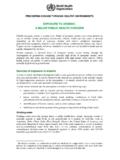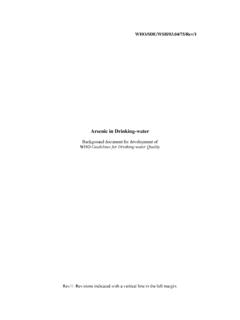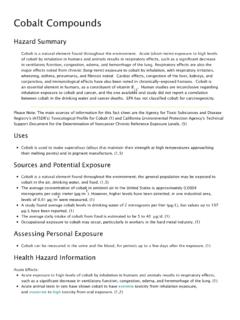Transcription of UN WomenWatch: www.un.org/womenwatch
1 UN WomenWatch: The UN Internet Gateway on Gender Equality and Empowerment of Women Fact Sheet Women, Gender Equality and Climate Change Detrimental effects of climate change can be felt in the short-term through natural hazards, such as landslides, floods and hurricanes; and in the long-term, through more gradual deg- radation of the environment. The adverse ef- fects of these events are already felt in many areas, including in relation to, inter alia, ag- riculture and food security; biodiversity and ecosystems; water resources; human health;. human settlements and migration patterns;. and energy, transport and industry. In many of these contexts, women are more vulnerable to the effects of climate change than men primarily as they constitute the majority of the world's poor and are more dependent for their livelihood on natural re- sources that are threatened by climate change. Photo Credit: UN Photo / Tim McKulka Furthermore, they face social, economic and political barriers that limit their coping ca- pacity.
2 Women and men in rural areas in developing countries are especially vulnerable when they are highly dependent on local natural resources for their livelihood. Those charged with the responsibility to secure water, food and fuel for cooking and heating face the greatest challenges. Secondly, when coupled with unequal access to resources and to decision-making processes, limited mobility places women in rural areas in a position where they are disproportionately affected by climate change. It is thus important to identify gender-sensitive strategies to respond to the environmental and humanitarian crises caused by climate It is important to remember, however, that women are not only vulnerable to climate change but they are also effective actors or agents of change in relation to both mitigation and adaptation. Women often have a strong body of knowledge and expertise that can be used in climate change mitigation, disaster reduction and adaptation strategies. Furthermore, women's responsibilities in households and communities, as stewards of natural and household resources, positions them well to contribute to livelihood strategies adapted to changing environmental An analysis of how women are affected by these issues; and how they respond, is provided below together with references to relevant United Nations mandates and information sources.
3 The Need for Gender Sensitive Responses to the Effects of Climate Change Women, agriculture and food security in the context of climate change Climate change has serious ramifications in four dimensions of food security: food availability, food accessibility, food utilization and food systems stability. Women farmers currently account for 45-80 per cent of all food production in developing countries depending on the region. About two-thirds of the female labour force in developing countries, and more than 90 percent in many African countries, Photo Credit: UNICEF/LeMoyne are engaged in agricultural In the context of climate change, traditional food sources become more unpredictable and scarce. Women face loss of income as well as harvests often their sole sources of food and income. Related increases in food prices make food more inaccessible to poor people, in particular to women and girls whose health has been found to decline more than male health in times of food shortages. Furthermore, women are often excluded from decision-making on access to and the use of land and resources critical to their For these reasons, it is important that the rights of rural women are ensured in regards to food security, non-discriminatory access to resources, and equitable participation in decision-making processes.
4 UN publications: Rural Households and Sustainability: Integrating environmental and gender concerns into home economics curricula Environment and Natural Resource Management: IFAD' s Growing Commitment Other resources on UN websites: Gender and Food Security Environment FAO FOCUS: Women and Food Security Climate Change, a Further Challenge for Gender Equity: How men and women farmers are differently affected Climate Change: Focusing on how the vulnerable can cope News Room: FAO pilots emerging strategies to alleviate weather-related consequences Women, gender equality and biodiversity in the context of climate change According to the Millennium Ecosystem Assessment, climate change is likely to become the dominant driver for the loss of biodiver- sity by the end of the century. Biodiversity plays an in important role in climate change adaptation and mitigation. For example, in contexts where deforestation is responsible for an average of 20% of human-induced carbon dioxide emissions, the conservation of natural habitats can reduce the amount of carbon dioxide released into the Additionally, the conservation of mangroves and drought-resistant crops can reduce the impacts of climate change such as flooding and famine.
5 In the rural areas of Africa and Asia, women and men are highly dependent on biomass, such as wood, agricultural crops, wastes and forest resources for their energy and livelihoods. How- ever, in the face of climate change, the ability of women and men to obtain these indispensable resources is It is important to note that the declining biodiversity does not solely im- pact the material welfare and livelihoods of people; it also cripples access to security, resiliency, social relations, health, and freedom of choices and The majority of the biodiversity decline has a disproportionate impact primarily on poor peo- ple in developing countries. To give a few examples, declining fish populations have major Photo Credit: FAO / Pius Ekpei implications for artisanal fishers and communities that depend on fish. Moreover, in many parts of the world, deforestation has meant that wood - the most widely used solid fuel - is located further away from the places where people live. In poor communities in most developing countries, women and girls are responsible for collecting traditional fuels, a physically draining task that can take from 2 to 20 or more hours per week.
6 As a result, women have less time to fulfil their domestic responsibilities, earn money, engage in politics or other public activities, learn to read or acquire other skills, or simply rest. Girls are sometimes kept home from school to help gather fuel, perpetuating the cycle of disempowerment. Moreover, when environmental degradation forces them to search farther afield for resources, women and girls become more vulnerable to injuries from carrying heavy loads long distances,9 and also face increased risk of sexual harassment and assault. Biodiversity, Indigenous Women and Climate Change Biodiversity also comes in the form of the wealth of knowledge on the environment that indigenous people and communities possess. Indigenous knowledge comprises: an understanding of wild ancestors of food, medicinal plants and domestic animals; symbiotic rela- tions with ecosystems; an awareness of the structure of ecosystems and the functionality of specific species; as well as the geographic ranges of said In order to further preserve biodiversity and limit its degradation, indigenous people can and should play a leading role in the global response to climate change.
7 This should be particularly emphasised with regards to indigenous women who play a vital role as stewards of natural A greater inclusion of indigenous communities and indigenous women further validates the significance of their knowledge. UN publications: Gender and Sustainable Development in Drylands: an Analysis of Field Experiences Gender and Desertification: Expanding roles for women to restore drylands Gender and Desertification: Making ends meet in drylands Gender and Equity Issues in Liquid Biofuels Production. Minimizing the risks to maximize the opportunities Rural Households and Sustainability: Integrating environmental and gender concerns into home economics curricula Energy and Gender: In rural sustainable development, Rome, 2006. 2004. Gender Perspectives on the Conventions on Biodiversity, Climate Change and Desertification. Rome, FAO Environment and Natural Resource Management: IFAD' s Growing Commitment Adivasi Women: Engaging with Climate Change (April 2009). Other resources on UN websites: Gender and Dryland Management: Gender roles in Transformation Gender Perspectives on the Conventions on Biodiversity, Climate Change and Desertification Insights into Gender and the Environment: Gender and Sustainable Land Management Sustainable Energy Services: The Gender Dimension Biodiversity for Development: The Gender Dimension People-Centred Climate Change Adaptation: Integrating Gender Issues Inter-agency Support Group on Indigenous Peoples: Issues Paper on Indigenous Peoples and Climate Change English, Permanent Forum on Indigenous Issues Seventh session 21 April - 2 May 2008, New York, 7.
8 Indigenous Women, Territoriality and Biodiversity in the Latin American Context (SPANISH). Women, gender equality and water resources in the context of climate change Climate change has significant impacts on fresh water sources, affecting the availability of water used for domestic and productive tasks. The consequences of the increased frequency in floods and droughts are far reaching, particularly for vulnerable groups, includ- ing women who are responsible for water management at the household All over the developing world, women and girls bear the burden of fetching water for their families and spend significant amounts of time daily hauling water from distant sources. The water from distant sources is rarely enough to meet the needs of the household and is often contaminated, such that women and girls also pay the heaviest price for poor To give an example, in cases where the arsenic contamination of groundwater is prominent, increased flood levels intensify the rate of exposure among rural people and other socio-economically disadvantaged The resulting health problems include: lesions, the hardening of skin, dark spots on hands and feet, swollen limbs and the loss of arsenic exposure also manifests itself in the form of skin lesions that usually have negative social repercussions for arsenic -poisoning (arsenicosis).
9 Victims the situation is particularly worse for women who can be shunned, excluded, and stigmatised, based on physical appearance . this also impacts the ability of single women to get married, and in many cases unmarried women are more vulnerable to poverty and social Given the changing climate, inadequate access to water and poor water quality does not only affect women, their responsibilities as primary givers, and the health of their families', it also impacts agri- cultural production and the care of livestock; and increases the over- all amount of labour that is expended to collect, store, protect and distribute water. Photo Credit: UNICEF / Pirozzi UN publications: Gender and Water Securing Water for Improved Rural Livelihoods: The multiple-uses system approach 2008. Climate change, water and food security. High Level Conference on World Food Security - Background Paper HLC/08/BAK/2. FAO. Other resources on UN websites: Towards Sustainable Food Security: Women and Water Resources Women and Water Gender, Water and Sanitation Women, gender equality and health in the context of climate change For In terms of health, some potential climate change scenarios include: increased morbidity and mortality due to heat waves, floods, storms, fires and droughts.
10 What's more, the risk of contracting serious illnesses is aggravated by environmental hazards caused by climate change. In addition to the reference provided above of climate impacting women's health through water scarcity and water contamination, an abundance of evidence links the evolution and distribution of infectious diseases to climate and weather. This en- tails a greater incidence of infectious diseases such as cholera, malaria, and dengue fever, due to the extension of risk seasons and wider geographic distribution of disease Whilst climate defines the geographical distribution of infectious diseases, weather influences the timing and severity of epidemics. Diseases transmitted by mosquitoes, for example, are particularly sensitive to variations in climate. Warmth accelerates the biting rate of mosquitoes and speeds up the maturation process of the parasites they carry. Sub-Saharan Africa is already home to the most effi- cient mosquito species and to the most severe forms of malaria.















